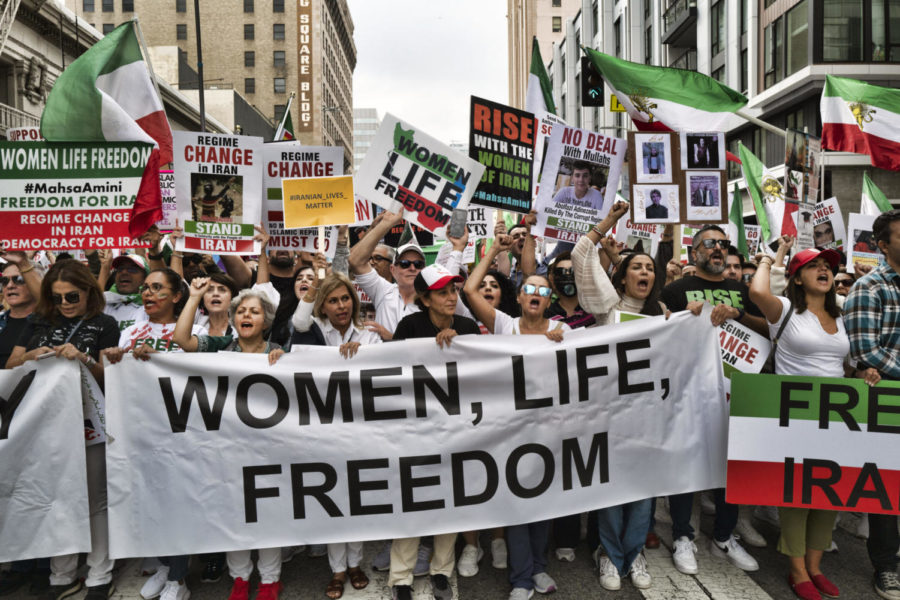Iranians protest restrictions, lack of rights for women
Women on the streets of Iran, protesting for human rights. (Photo courtesy of Associated Press, licensed through Creative Commons)
December 23, 2022
“Woman, life, freedom!” In recent months, this chant has been heard across the world in a series of protests for Iranian women’s rights. Iranian women are burning their hijabs and cutting their hair to fight for their rights in a revolutionary movement advocating for regime change.
On Sept. 13, 22-year-old Kurdish-Iranian woman Jina “Mahsa” Amini was arrested in Tehran by Iran’s morality police for wearing her hijab ‘too loosely’. Three days later, after being tortured and beaten by authorities, she fell into a coma and died.
As news of Amini’s death emerged, towns and cities erupted into protests that are being recognized throughout the world. As of Nov. 30, Amini’s name has been used as a hashtag 79 million times.
Authorities have responded with violence, and at least 448 protestors in Iran have been killed, according to Iran Human Rights.
Iran’s restrictions on women do not end at the mandatory hijab; women are confronted with discrimination on marriage, divorce, and child custody, and have been sent to jail for publicly speaking in favor of women’s rights. Women cannot divorce, cannot get abortions, and are watched by Iran’s morality police, established in 2005 to enforce these restrictions by regulating women’s bodies.
“No woman should have to fear for their lives because their hair is showing,” junior Hana Mahdood said. “That’s not how reality is, and I think that these restrictions are nothing but inhumane and controlling.”
The Islamic Penal code states that “women who appear in public places and roads without wearing an Islamic hijab shall be sentenced ten days to two months’ imprisonment or a fine of five hundred to fifty thousand rials.” These stringent policies sparked a wave of outrage throughout Iran, and tension has been building since the 1979 revolution.
“The restrictions placed on women are outdated, and Iranian young women are rising up in opposition to the years of oppression and degrading treatment that they have gone through,” sophomore Humsa Tammera said.
If women do not wear hijabs, they cannot receive services from institutions such as banks and hospitals. Now, Iranian women are fighting for the right to choose. “All people should be able to express themselves freely,” freshman Jaidon Faircloth-Scott said.
People have been protesting the mandatory rule prior to the current protests, and this unrest is not new. The nonprofit organization, My Stealthy Freedom started the “White Wednesdays” movement in 2017, where men and women wear white veils, scarves, or bracelets to demonstrate their resistance to the mandatory hijab rule. The campaign is open to women who wear the hijab willingly, but are opposed to imposing it on others.
“This is not a fight against Islam,” Mahdood said. “Women should be free to practice their religion, whatever it may be, and women are tired because they’re being forced into something they don’t want to be forced into. This is more of a fight for freedom.”
In response to the protests, the Iranian government claimed to disband the morality police. However, the validity of this claim remains disputed.
“I still have much of my family still living in Iran, sadly, and they told me that it’s not true,” Mahdood said. “Instead of taking you into a specialized car, the morality police are actually going to take you into an ambulance now. So it’s just going to look like your average ambulance, but inside of it are probably women who could be at risk of losing their lives.”
After months of protesting, Iran continues to enforce the mandatory hijab law. “Hijabs still being mandatory in Iran just shows that the Iranian government does not plan to change its core laws and restrictions on women,” Tammera said. “The government is caving into outside pressure after three whole months of violent protests around the world, so I’m not sure if they will continue taking action.”
Some believe that any tangible change resulting from the protests must stem from policies. “Protests can help get the movement out there, but I believe that to do full change, it has to start convincing people in key positions or getting into those positions who actually affect change to implement that actual policy,” Faircloth-Scott said.
Those who advocate for revolutionary reforms agree that concrete government action is needed. “The only way there can be a change in Iran is if government officials decide to take action and change things,” Tammera said.
Despite the multiple accounts in which Iranian women have fought for their rights in the past, some are looking to the future with renewed hope. “I don’t like calling it a protest because at this point, this is a revolution. No matter how long this is going to take, I know the women are going to continue fighting for their freedom,” Mahdood said.



